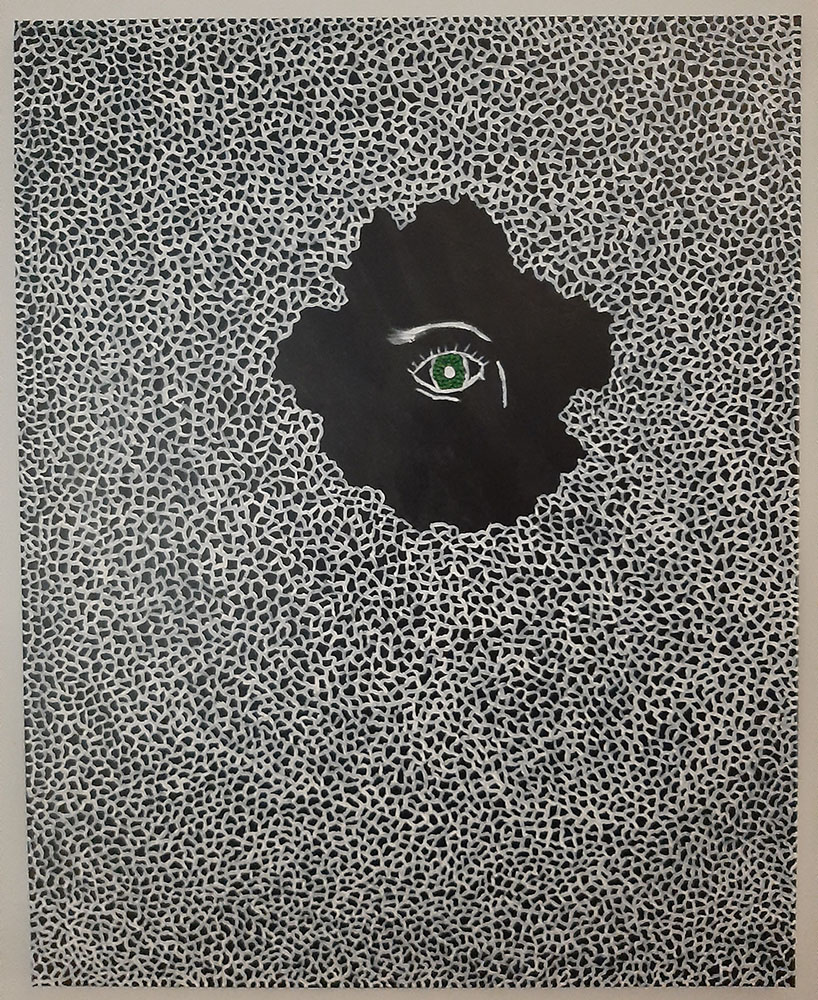A Glass Darkly

For now we see through a glass, darkly; but then face to face: now I know in part; but then shall I know even as also I am known. (1 Corinthians 13:12).
1 Corinthians 13 is a common reading in the ministry of ceremonies; that is, at weddings and funerals. Mainly because of the nice, comfortable sounding passage about love, how it is kind, patient and all the rest. But what keeps striking me the more I read it, is the line about the glass or mirror. Not only is this a passage about the impassibility, the transcendent power of love, but a passage about transitions. When I was a child, I thought and spoke like a child. I knew only in part, but in time I will come to understand the whole. What this passage from Paul’s first letter to the Corinthians can teach us is not a vacuous concept of love, but the solidarity of love in life’s transitions.

A Glass, Darkly
2020
75 x 60cm
Acrylic on canvas
Life is full of cracks, as though we have Paul’s glass or mirror, and each little event in our lives takes a hammer and nail and makes a tiny fracture on the polished surface. Each fracture in turn can lend a certain ugliness to our lives, at least in the eyes of some observers. Even though the human condition begs a sense of community, of belonging, sometimes our cracks can be too much for others to bear. As life goes on, we become this virtually porous surface, hardened to pain, but also undeniably fragile, needing frequent maintenance, and all-around unattractive to the untrained eye. These fractures, however numerous, represent a transition in our life, in our reality, and it is the Christian conviction that Christ encounters us at each tiny break. The same way the risen Christ was revealed to his followers in the breaking of the bread, he is supremely present in the transitory fractures in the human life. We move, as Paul suggests, from an infantile understanding of life and faith, gradually, to a more mature and rounded understanding. We move from being an innocent outsider to someone the world has, if you’ll excuse the expression, chewed up and spat out. But in being digested by worldly bodies, we come to digest a richer understanding of the human condition. We see the glass, we see the mirror, and we develop this understanding of our place as a crack on its surface, just as our own surface has been dinted by experience. We don’t see the risen Lord in a shining, untarnished statue, but in each one of these cracks. It is the reality of life that causes these cracks, and the reality of God that positions them such that the surface does not break, but rather forms an intricate new structure. We are built up by our experiences, by our defects, our defeats, our pain, our transitions. It’s as though this glass separates us from seeing God with clarity, until, ironically, we only have full vision of God’s promises when the surface is marred. God takes what is broken and makes it holy, sets it like a fragment in the mosaic that is the Kingdom. A pattern of broken lives joined together to form a new lens by which to see Christ. We are never the same after life’s transitions, but we develop, we grow, we mature in our understanding, and our empathy.
The paradox of the Kingdom is that we will not see Christ in a polished glass, but only when it is fractured and fractured and fractured to create a new viewing partition. One where we are challenged to look harder, but whereby the rewards of our discernment are rewarded all the more richly. We start to see Christ in the cracks; at once both less and more of ourselves. But our united selves, drawn together by common pain, common struggle, and thus united with the Saviour’s pain on the Cross. The truth of the Lord is that he does not come in splendour, but in agony; robed in blood, enthroned on a dead tree. This is the Christ who understands our pain, who sees us through a glass, darkly, whom we will come to know as fully as he knows us.
David Kerr is an ordained minister in the Anglican Diocese of Wangaratta, northeast Victoria. He has trained in theology, media communications and social theory, and has been a practicing visual artist since 2016.
